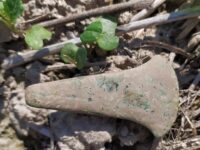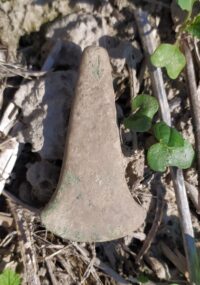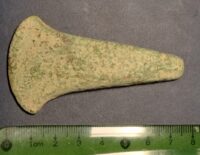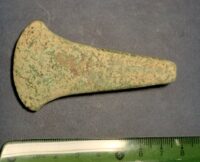 A copper axe dating to the 4th-3rd millennium B.C. is the oldest ever discovered in Poland. It may be the oldest copper artifact ever found in Poland.
A copper axe dating to the 4th-3rd millennium B.C. is the oldest ever discovered in Poland. It may be the oldest copper artifact ever found in Poland.
 It was found last August at a metal detectorist rally in the town of Matcze in southeastern Poland near the border with Ukraine. The rally was done with the permission of the Lublin Provincial Monument Protection Office, and the site was scanned in advance to salvage any archaeological materials while leaving behind more modern objects for the club members to find. The precaution proved ineffective when Krzysztof Gajos discovered a small copper axe. The find location was pinpointed with GPS and the artifact handed over to the Zamość delegation of the Monument Protection Office.
It was found last August at a metal detectorist rally in the town of Matcze in southeastern Poland near the border with Ukraine. The rally was done with the permission of the Lublin Provincial Monument Protection Office, and the site was scanned in advance to salvage any archaeological materials while leaving behind more modern objects for the club members to find. The precaution proved ineffective when Krzysztof Gajos discovered a small copper axe. The find location was pinpointed with GPS and the artifact handed over to the Zamość delegation of the Monument Protection Office.

 The axe has a fan-shaped blade 7.4 cm (3 inches) long, 4.1 cm (1.6 inches) wide and 1 cm (.4 inches) thick at the thickest point. Made with a simple casting method that predates the Bronze Age when copper axes became widespread, the axe has no comparable example on the archaeological record of Poland. An axe found in the Kiev region of Ukraine is virtually identical, however, and it was found with pottery fragments that identified it as the work of the Neolithic Cucuteni–Trypillia culture which occupied parts of modern-day Bulgaria, Romania, Moldova and western Ukraine.
The axe has a fan-shaped blade 7.4 cm (3 inches) long, 4.1 cm (1.6 inches) wide and 1 cm (.4 inches) thick at the thickest point. Made with a simple casting method that predates the Bronze Age when copper axes became widespread, the axe has no comparable example on the archaeological record of Poland. An axe found in the Kiev region of Ukraine is virtually identical, however, and it was found with pottery fragments that identified it as the work of the Neolithic Cucuteni–Trypillia culture which occupied parts of modern-day Bulgaria, Romania, Moldova and western Ukraine.
“It is true that we have recorded finds of Trypillian culture pottery from Gródek, Hrubieszów commune, and the presence of this ax in nearby Matcz can be considered as confirmation of the settlement of people of this culture also in eastern Poland, at least in the section of the upper Bug. This thesis may also be confirmed by a loose find a similar copper ax in Wożuczyn, Rachanie commune, Tomaszów poviat, about which Dr. Jan Gurba wrote , and which should now be at the Institute of Archeology of the Maria Curie-Skłodowska University in Lublin,” commented [the Lublin Provincial Conservator of Monuments].
The axe will be transferred to the Stanisław Staszic Regional Museum in Hrubieszów where it will be studied and analyzed further.
* This article was originally published here












No comments:
Post a Comment